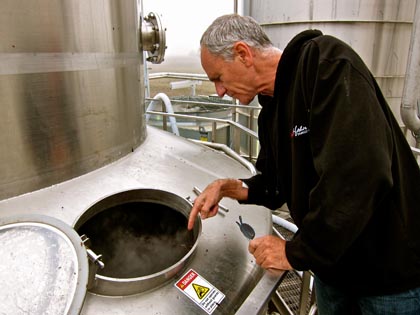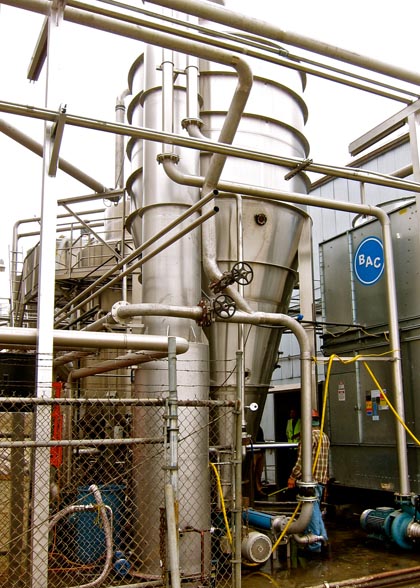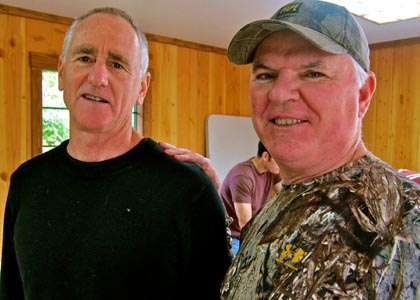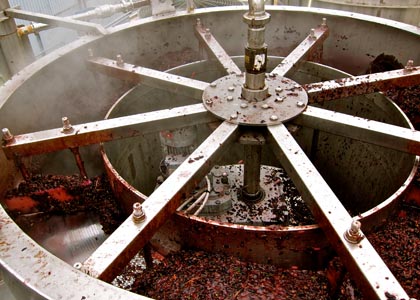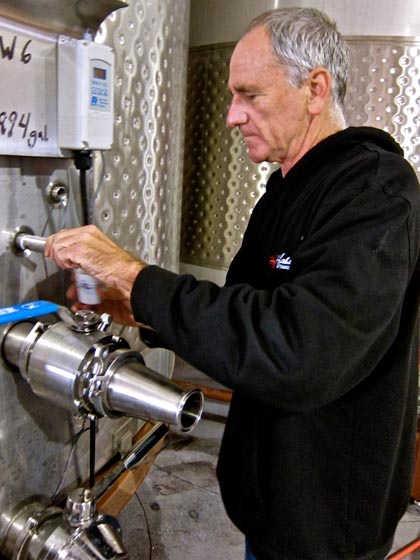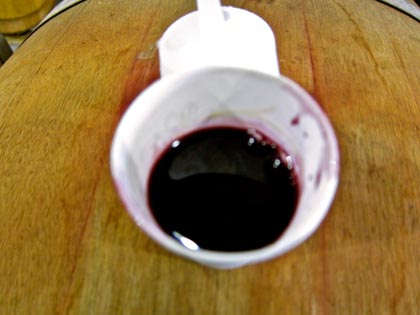Letters from Lodi
An insightful and objective look at viticulture and winemaking from the Lodi
Appellation and the growers and vintners behind these crafts. Told from the
perspective of multi-award winning wine journalist, Randy Caparoso.
Flash of new insights into Lodi wine
Renowned Lodi winemaker/consultant Barry Gnekow monitors Cabernet Sauvignon undergoing "Flash Detente" extraction
How Barry Genkow and Flash Détente’s new technology helps us an understand an old concept
The Flash Detente condenser
One of Lodi’s finest wines is m2 Wines’ Soucie Vineyard Zinfandel; which, vintage after vintage, is distinguished by an almost European quality that can only be described as earthy, loamy, and often mushroomy. M2 winemaker/proprietor Layne Montgomery often likens this wine’s distinctive complexity to the smell of “onions cooked in a beef stew.”
Because you cannot find this particular quality in Zinfandels grown in other parts of Lodi’s Mokelumne River AVA – demarcated by the flat, deep, rich sandy loam soils planted by the original settlers in Lodi, starting in the 1860s – the logical conclusion is that it is the specific soil under the Soucie Vineyard that makes its Zinfandels so different.
The French, in fact, have always had a great word for this type of natural vineyard distinction: terroir.
Yet here’s a curious fact: when you study soil analyses based upon U.S. Department of Agriculture reports, comparing the soils and subsoils in the area around Soucie Vineyard with the soils and subsoils in the rest of the Mokelumne River, there is almost no difference: the entire Mokelumne River region has pretty much the same soil identified as Tokay Sandy Loam. Soils throughout the AVA are pretty much uniform mixes of loam and silty sand.
So, whence the “Soucie spice,” as Montgomery calls it?
Earlier this year we sat in on a presentation by the widely respected Lodi based wine consultant, Barry Gnekow – who counts Michael~David, Klinker Brick, and Lodi Vintners among his major clients – on the results of a new machine called Flash Détente: the latest in winery technology, in use in Europe, South America and Australia for over a decade, but brought over to California for for the first time in 2009.
Barry Gnekow with Michael~David CEO/co-owner Michael Phillips, a Flash Detente enthusiast
Just before the 2010 harvest, one of these French designed, Italian manufactured contraptions (price tag: $1 million) was installed in Lodi Vintners on E. Woodbridge Rd., and since then Michael-David, Mettler Family and numerous other wineries have been for blending small proportions of flash extracted wines – like “adding to our spice rack,” according winemaker Adam Mettler – to improve their wines.
Flash extraction basically involves rapid heating of grapes (2-5 minutes) to very high temperatures (up to 180° F.) followed by instantaneous cooling in a vacuum chamber, causing immediate extraction of color, tannin and skin colloids due to rupturing. The détente, or “relaxing,” involves the steam that goes into the condenser, and it is the condensate loaded with less desirable qualities like pyrazines – the compounds that give grapes like Cabernet Sauvignon, Merlot and Sauvignon Blanc their green, herbaceous, often bell peppery aroma/flavors – that gets separated from the extracted juice, basically in the form of H2O.
Gnekow calls the liquids condensed by Flash Détente “flash water,” and he has been saving samples of this water to demonstrate what kinds of undesirable odors this machine helps remove. In fact, Gnekow’s original introduction to the technology was with a Merlot based Bordeaux that had been flashed: it was after tasting the resulting flash water from this Bordeaux, which he describes as “pure veg,” that he came to the conclusion that this machine “could be just as transformative for the California industry.”
Not everyone will be a huge fan of this new fangled technology, but there is no doubt: Flash Détente can help concentrate the fruit qualities of wines. The biggest drawbacks, or concerns, might be the reduction of both varietal as well as terroir related qualities — what is a Beaulieu Private Reserve, for instance, without its nuances of minty pyrazine and “Rutherford dust”? Not every grape or vineyard will benefit from Flash Détente.
Grapes pumped into top of Flash Detente, colliding with 180 degree heat for instantaneous extraction.
When Gnekow does his presentations, he also offers samples of flash waters he has collected from various vineyards: notably, water removed from a Malbec showing a pleasing scent of almond biscotti – grown in a vineyard with a large almond orchard next door. Gnekow also shows the condensate from a Pinot Noir grown next to a highway in Carneros – the water smelling almost exactly like car exhaust. The most telling? Water from an Amador County Zinfandel that smells distinctly of manure – this vineyard surrounded by grazing Black Angus.
After swirling and smelling Gnekow’s water samples it suddenly dawned on us, where the natural, earthy qualities in the Zinfandels from Soucie Vineyard probably come from: the two dairies located along along I-5, both within two miles from Soucie. It might very well be the pungent scent of happy cows carried through the vineyard each day by the gentle Delta breeze!
For years, of course, aficionados of other wines around the world have been very cognizant of vineyard distinctions that are not so much terroir as air-roir related: the minty/eucalyptus character of Heitz Martha’s Vineyard bottlings from vintages past, for instance; the lavendery/juniper/thyme-like variations of garrigue associated with many wines of Provence and Languedoc; the scrubby/flinty/sea salty maquis found in the wines from Corsica; the foresty, sometimes pine-like, sometimes redwoodish complexity of wines grown in the Occidental and Freestone areas of Sonoma Coast… qualities more than likely coming from the air surrounding vineyards, rather than from underfoot.
Airroir: a new definition of terroir, explaining why many of the world’s most unique wines taste the way they do? Let’s not overthink this: if it walks like it, and talks like it, what else could it be?
Barry Gnekow drawing Cabernet Sauvignon that has just been flash extracted, ready for fermentation
A big boon for Lodi
No one is as excited about the benefits of Flash Détente as Gnekow. “It’s a godsend in years like this,” he tells us, “when you have problems with mold and underripe, green fruit. For example, this year (2011) we took a lean, underripe Syrah that had to be picked early, at 21° Brix (i.e. sugar reading) before it was totally rotted by rains, and we turned it into something special, while bringing its sugars up to 25°.
“But I don’t want anyone to think that Flash Détente is just about fixing problems. Another big plus is that it is an extraction process, thereby making it possible to circumvent traditional red wine processing, like pump-overs, because what comes out is more concentrated, ready-to-ferment juice, without the skins, minus 10% of its water. With that, you can go straight into barrel for fermentation” – something Lodi’s Mettler Family and Michael David Winery have already been taking advantage of. Many of Australia’s top producers, and a few Californians, have known and implemented red wine barrel fermentation for years for the express purpose of producing wines of softer tannin, and more supple, cohesive qualities.
In fact, there are already a number of high profile Napa Valley Cabernet Sauvignon producers (who shall go unnamed) standing in line to have their grapes flash extracted at Lodi Vintners. “It bothers some of them no end that they have drive a whole hour and half to Lodi to get their grapes processed,” says Gnekow, “but there are only two of these machines in the state. I just tell them to bring their grapes over in the afternoon, and we can get them processed overnight and back in time for them to enjoy their lunch at Auberge du Soleil the next day.”
Flash extracted Cabernet Sauvignon undergoing barrel fermentation
Asked how long it will take for their investment in the Flash Détente to pay off, Gnekow tells us, “it’s already paid for itself. Frankly, I don’t know why the industry in California took so long to come around to it. Flash Détente is especially good for Lodi, because our growers get three, four times less for their grapes than they do in Napa Valley. Just to survive we have to crop our grapes higher, which is a disadvantage from a quality standpoint. But by taking out the pyrazines that might result from higher cropped Cabernet Sauvignon and Merlot, Flash Détente can help growers in Lodi by levelling the playing field.”
Yet Gnekow cautions, “Flash Détente is not the answer to everything, but it is one more tool to help producers in Lodi improve the quality of their wine, and that’s what really matters.”
